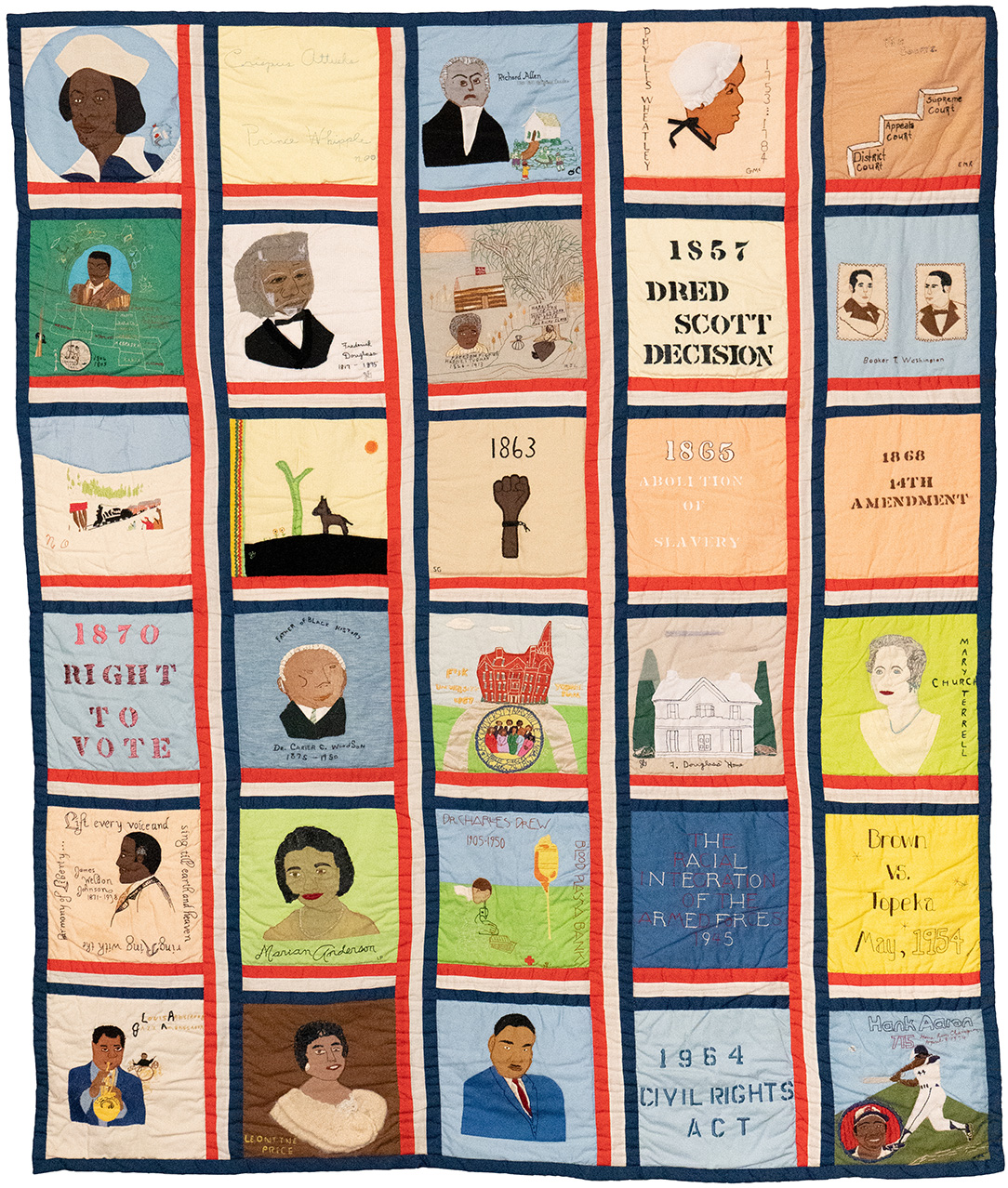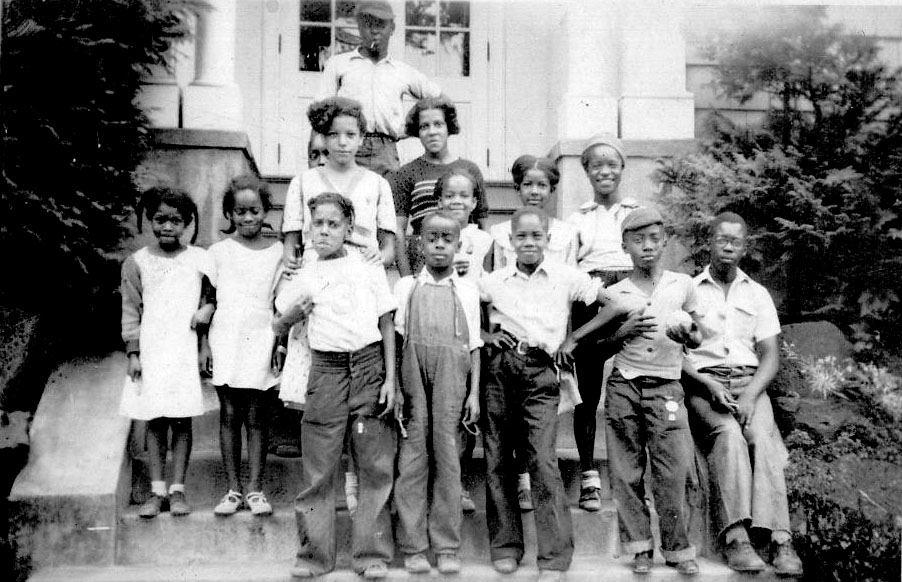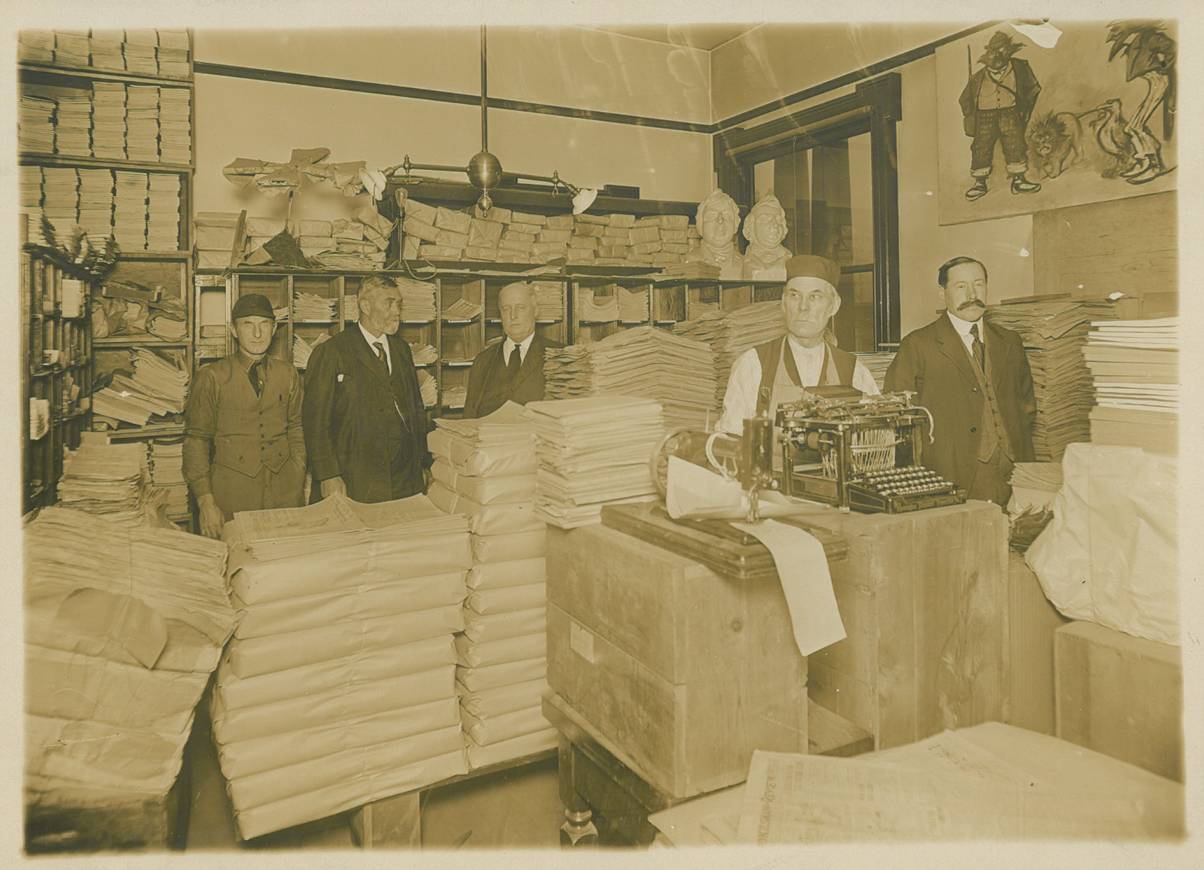The Afro-American Bicentennial Commemorative Quilt, in the collections of the Oregon Historical Society, depicts five hundred years of national equality issues and African American personalities in the United States. In 1974, independent scholar Mrs. Osly J. (Jeannette McPherson) Gates conceived the idea of making a quilt as part of her broader project commemorating African Americans in U.S. history to be exhibited at the Oregon Historical Society in Portland in 1976.*
Mrs. Gates recognized the Bicentennial as a national landmark event and did not want Black history ignored. For her, African Americans are unified by three factors: religious heritage, struggle against oppression, and strength of family ties. The project's other component honored the contributions and sense of community of African Americans in Oregon by borrowing their family heirlooms for an exhibit.
Mrs. Gates selected fourteen prominent, socially motivated Black friends in Portland who she knew celebrated their heritage.** They were not quilt-makers, but for two years the fifteen women collaborated on a thirty-block quilt that revealed “the markings on the road to freedom from multi-dimensional aspect of human endeavor.” The quilt blocks were created to show “critical economic, political and social equality as well as significant cultural contributions which shaped America.” The project included keeping thorough records of meeting minutes, monthly newsletters, the audit report, and a scrapbook of newspapers clippings, correspondence, and other ephemera.
The 73½-by-87½-inch quilt is constructed of thirty 12-inch appliquéd or stenciled blocks of cotton and cotton percale, with embellishments of embroidery stitches and knitting. The blocks are set with 3-inch sashing strips of red, white, and blue, a recognized symbol of Bicentennial quilts. The quilting stitches are simple vertical and horizontal lines that follow the edges of the sashing strips.
The quilt tells a story, or narrative, using a style popular with African American quilt-makers who used fabrics to create images that invoke memories, history, or lessons from personal experiences. This quilt is unique as a group quilt exercise that honors a broad spectrum of Black experiences. The blocks commemorate the key constitutional acts that affect African Americans: the 13th, 14th and 15th Amendments; and they honor Black luminaries—singers Marian Anderson, and Leontyne Price, jazz musician Louis Armstrong, and baseball player Hank Aaron. Each quilt-maker chose the number of blocks to make, the subject, and the stitching technique. The quilters also wrote personal statements about their subjects' history and significance, which were gathered in a booklet that is an essential educational tool for the quilt.
In the early 1970s, quilt-making was experiencing a revival through the back-to-nature movement, which creatively used the crafts of earlier generations; the landmark Whitney Museum hanging quilt exhibition in 1971; Black studies programs at universities; the feminist movement; and the focus on the Bicentennial and the heritage and heirlooms of the United States. Quilts, as symbols of women’s artistic expression, became popular interpretations. This quilt, like others, offered quilt-makers the opportunity to question government action in blocks depicting "Forty Acres and Mule" and “Dred Scott Decision”; to commemorate national history in "Civil Rights Act of 1964" and "Brown vs. Topeka"; and to express pride in ancestors such as Harriet Tubman, Phyllis Wheatley, and Mary Church Terrell. A comparable group-made quilt, the People's Bicentennial Quilt, which honors the evolution of American minority societies, is in the collection of the International Quilt Museum in Lincoln, Nebraska.
The Oregon Bicentennial Quilt traveled throughout the state as part of the US National Bank–Oregon Historical Society’s Bicentennial Express, inspiring many communities to create their own heritage quilts. Those quilts are visual records of the state's history, economics, and geography. In recent decades, scholars have studied quilters' ethnicity and distinct traditions and focused on quilts as visual documents of human experience. The title of this quilt, the Afro-American Heritage Bicentennial Commemorative Quilt, clearly reflects its subject, ethnicity, and purpose.
Mrs. Gates’s vision was to exhibit the quilt nationally, and she wrote cities, churches, universities, magazines, and newspapers that had connections with the quilt's subjects. Because of her efforts, the quilt was exhibited at the U.S. State Department Exhibition Hall in Washington, D.C., the Schomburg Center for Research in Black Culture (a branch of the New York City Library in Harlem), and the W.E.B. DuBois Institute Gallery at Harvard University.
As interest in African American quilts expanded, the quilt was included in several exhibitions and publications. It was featured, for example, in the 1989–1991 touring exhibition Stitching Memories: African-American Story Quilts, curated by Eva Ungar Grudin for Williams College Museum of Arts in Williamstown, MA. It was also included in a 2000 exhibition, Quilts: Stitched Records of Human Experience, curated by Mary Bywater Cross at the Washington State University Archives in Pullman as part of the Women's West Conference, "Gender, Race, Class and Region in the North American West." The quilt was featured in A Communion of Spirits: African American Quilters, Preservers, and their Stories, by Roland Freeman (1986), and Black Thread: An African American Quilting Sourcebook, by Kyra E. Hicks (2003).
The Afro-American Heritage Bicentennial Commemorative Quilt continued to serve as a primer on American Black history in 2020. On October 11, it was snatched by vandals who invaded the Oregon Historical Society building where it was on exhibit. The quilt was found blocks away, wet and dirty, and is undergoing restoration.
*Mrs. Gates never used her own first name and always identified herself by her married name, a common practice in the 1970s. The author has requested that The OE honor that preference.
**Kathryn Hall Bogle, June Borders Brown, Ozella Canada, Sarah Mayfield, Jeanette McPherson Gates, Sylvia J. Gates, Mildred J. Love, Gladys Sims McCoy, Rebecca J. Miller, Naomi Owens, Martha M. Payne, Lylla Phillips, Mildred Reynolds, Eddie M. Rollins, Hazel Beatrice Whitlow
-
![]()
The Afro-American Bicentennial Commemorative Quilt.
Oregon Historical Society Museum
-
![]()
Members of the Afro-American Bicentennial Commemorative Quilt Committee, 1976.
Oregon Historical Society Research Library, OrHi50382
-
![]()
Leontyne Price on block 27 of the Afro-American Bicentennial Commemorative Quilt.
Oregon Historical Society Museum
-
![]()
Installation of the Afro-American Bicentennial Commemorative Quilt at OHS, 2020.
Oregon Historical Society Museum
Related Entries
-
![Black People in Oregon]()
Black People in Oregon
Periodically, newspaper or magazine articles appear proclaiming amazeme…
-
![Oregon Historical Society]()
Oregon Historical Society
The Oregon Historical Society is a private museum, archival library, an…
-
Oregon Trail quilts
Quilts made by and for women who traveled the Oregon Trail between 1840…
Related Historical Records
Further Reading
Afro-American Heritage Bicentennial Commemorative Quilt. Mss 2432, Oregon Historical Society Research Library, Portland.
"World Quilts: The American Story." International Quilt Museum.
Young Yu, Connie. Patchwork History: The People's Bicentennial Quilt, Saratoga, Calif.: Saratoga Historical Foundation, 2010.
Tymchuk, Kerry. "OHS Statement on Building Vandalism." OHS.org.







